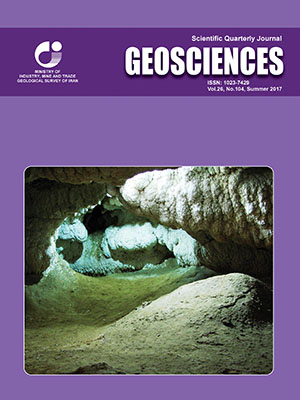References
Alavi, M., 1991- Sedimentary and structural characteristics of the Paleo-Tethys remnants in northeastern Iran. Geological Society of America Bulletin, 103, p. 983-992.
Ambraseys, N. and Melville, C., 1982- A History of Persian Earthquakes, Cambridge University Press, New York, p. 219.
Berberian, M. and King, G.C.P., 1981- Towards a paleogeography and tectonic evolution of Iran: Canadian Journal of Earth Sciences, 18, p.210-265.
Berberian, M., 1995- Master blind thrust faults hidden under the Zagoros folds: active basement tectonics and surface morphotectonics. Tectonophysics, 241, p. 193–224.
Brun, J. P. and Nalpas, T., 1996- Graben inversion in nature and experiments. Tectonics, Vol. 15, No. 2, p. 677-687.
Eftekharnejad, J., and Behroozi, A., 1991- Geodynamic significance of recent discoveries of ophiolites and late Paleozoic rocks in NE Iran (including Kopet Dagh): Abhandlungen der Geologischen Bundesanstalt, v. 38, p. 89–100.
Falcon, N., 1974- Southern Iran: Zagros mountains. In A. Spencer (Ed.), Mesozoic- Cenozoic orogenic belts. Geological Society of London, Special Publication, 4, p. 199-211.
Hollingsworth, J., 2007- Active tectonics of NEiran. Ph.D. thesis, Queen’s college, University of Cambridge, p. 239.
Kavoosi, M. A., Sepehr, M. and Sherkati, S., 2009- Kopeh Dagh basin evolution during Middle-Late Jurassic.First International Petroleum Conference & Exhibition, Shiraz, Iran.
Lyberis, N. and Manby, G., 1999- Oblique to orthogonal convergence across the Turan block in the Post-Miocene. American Association of Petroleum Geologists Bulletin, 83, p. 1135-1160.
Motaghi, K., Tatar, M., Shomali, Z. H., Kaviani, A. and Priestley, K., 2012- High resolution image of uppermost mantle beneath NE Iran continental collision zone. Physics of the Earth and Planetary Interiors 208–209 , p. 38–49.
Robert, A. M. M., Letouzey, J., Kavoosi, M. A., Sherkati, S., Müller, C., Vergés, J. and Aghababei,A., 2014- Structural evolution of the Kopeh Dagh fold-and-thrust-belt (NE Iran) and interactions with the South Caspian Sea Basin and Amu Darya Basin. Marine and Petroleum Geology 57, p. 68-87.
Ruttner, A., 1991- The Triassic of Aghdarband (AgDarband), NE-Iran, and its pre-Triassic frame. In: Abhandlungen der Geologischen Bundesanstalt, vol. 38, p.252.
Sheikholeslami, M. R. and Kouhpeyma, M., 2012- Structural analysis and tectonic evolution of the eastern Binalud Mountains, NE Iran. Journal of Geodynamics, 61, p. 23-46.
Sherkati, S. and Letouzey, J., 2004- Variation of structural style and basin evolution in the central Zagros (Izeh zone and Dezful Embayment), Iran. Marine and Petroleum Geology, 21, p. 535–554.
Stocklin, J., 1968- Structural history and tectonics of Iran, a review. AAPG Bull., v.52, No.7, p. 1229-1258.
Taheri, J., Fürsich, F. T. and Wilmsen, M., 2009- Stratigraphy, depositional environments and geodynamic significance of the Upper Bajocian-Bathonian Kashafrud Formation, NE Iran.Geological Society, London,Special Publications 312, p. 175-188.
Thierry, J., 2000- Middle Callovian (157–155 Ma). In: Dercourt, J., Gaetani, M. etal. (eds) Atlas Peri-Tethys Palaeogeographical Maps. CCGM/ CGMW, Paris, p. 71–97.
Thomas, J., Cobbold, P., Shein, V. and Douaran, S. L., 1999- Sedimentary record of Late Paleozoic to recent tectonism in Central Asia–analysis of subsurface data from the Turan and South Kazak domains. Tectonophysics 313, p. 243–263.
Trifonov, V., 1978- Late Quaternary Tectonic Movement of Western and Central Asia. Geological Society of America Bulletin, 89, p. 1059–1072.
Zanchetta, S., Berra, F., Zanchi, A., Bergomi, M., Caridroit, M., Nicora, M. and Heidarzadeh, G., 2013- The record of the Late Palaeozoic active margin of the Palaeotethys in NE Iran: Constraints on the Cimmerian orogeny. Gondwana Research 24, p. 1237-1266.
Zanchi, A., Zanchetta, S., Balini, M. and Ghassemi, M. R., 2015- Oblique convergence during the Cimmerian collision: evidencefrom theTriassic Aghdarband basin, NE Iran, Gondwana Research, doi:10.1016/j.gr.2015.11.008.

